Floods
Falmouth has a long history of “damaging floods”. Our historian, Jerrilynn Eby compiled this list of floods that have occurred between 1738 and 1972. There have been 18 major floods in 234 years averages 1 damaging flood every 13 years. That, of course, isn’t counting the many floods that covered River Road with water during the intervening periods.
This is by no means a list of ALL floods that brought water onto King’s Street/River Road in Falmouth, but merely a compilation of those floods that damaged buildings, bridges, or other property in that area.
1738—damaged tobacco in Falmouth warehouse (McIlwaine, Journals, 1727, p. 286).
Summer 1771—flood “carried away several Warehouses with all the Tobacco in them” (about 4,000 hogsheads) (Mason, p. 159). This flood also washed away part of King’s Street (Town 10).
1784—Ice floe took out the ferry house (Town 21).
First Falmouth bridge opened circa 1798.
August 1807—Falmouth bridge “entirely swept away by the destructive torrent” (Virginia Herald, Aug. 14, 1807). The bridge to what is now called Lauck’s Island was also destroyed at this time (Virginia Herald, May 13, 1808). The island bridge was rebuilt, but was washed out the following year (Virginia Herald, May 13, 1808).
March 1818—Falmouth bridge abutment “undermined by the current and sunk several feet.” The flood “brought down with it an unusual quantity of old logs, &c. which formed a lodgement” damaging the lower bridge (below the Chatham Bridge) and making it unsafe for vehicles or foot traffic (Virginia Herald, Mar. 25, 1818). This flood also took out the Chatham Bridge (Tomlin).
June 1826—Chatham Bridge washed out—“On Sunday and Sunday night, we experienced a very heavy fall of rain in this neighborhood [Fredericksburg], which extended to the mountains. The consequence has been, a higher rise of water in the Rappahannock than has taken place since July, 1814. The destruction of mills, bridges, and growing crops has been immense. Both the bridges across the river at this place have been entirely swept away. The Hazel Run and the Mattapony, on the route to Richmond, continued impassable during all yesterday. No mail was sent from this office, nor was any received from the South. The mail for the North went out as usual, the stages crossing the river at Falmouth, the bridge at which place stands firm. By this route, the distance from Belle-plain to this office is increased about three miles. This morning, the water in the river having subsided to nearly its usual height, the mail departed for the South, at the regular hour; — and the mail from the South, due yesterday, at 4 o’clock, P. M., was received at 7 A. M., in good order. No further obstruction of the mail is apprehended at present” (Phenix Gazette, July 1, 1826).
1828-1832—sometime during this period the Chatham Bridge was destroyed by flooding (Political Arena, June 29, 1832).
April 1852 – “At Fredericksburg the Rappahannock has risen within a few feet of the height known to the oldest inhabitant—carrying off a portion of the Chatham Bridge and causing a terrible shaking of the Falmouth bridge” (Richmond Enquirer, Apr. 23, 1852).
July 1857 – “The repeated rains and storms of Wednesday caused a flood in Kyger’s run [Falls Run], in Falmouth about midnight, which nearly swamped one half the town. The large warehouse of Mr. Forbes, which has stood for fifty years about thirty feet from the ordinary channel of the run, built on two feet of stone foundation, was swept down a hundred yards against another warehouse by the bridge, demolishing it utterly, and creating a general smash of both. Each warehouse was full of goods, 1000 bushels of corn, sugar, bacon, salt, &c, &c., estimated loss $500. Mr. O’Bannon’s warehouse and store was flooded and damaged his goods to amount of about $200. The Houses of Mrs. Latham, Messrs. Green, Stiars and Reeves, and Edwards, &c. &c., were flooded four feet deep. Old Mrs. Latham was rendered speechless by the shock, and died the following Sunday. Stiars’ house was almost swept away. An old negro woman was floating around the room on her bed in Mr. Latham’s house and reached the steps and thus escaped” (The Daily Dispatch (Richmond, VA), July 10, 1857).
April 1861—Flood waters “[swept] away panel after panel of the Falmouth Bridge, which with similar velocity, borne down by the impetuous current, struck the Chatham Bridge…and carried off about one third of that structure…In a few hours the whole of Falmouth Bridge had disappeared” (Fredericksburg News, Apr. 12, 1861).
August 1875—A flood destroyed the bridge to Lauck’s Island (Virginia Herald, Aug. 23, 1875).
1886—Stafford County bought the rights to the Falmouth Bridge from the Ficklen family and built a new bridge near the site of the old one. By mid-December 1886 two spans of the new bridge were in place and a third was nearing completion. A Fredericksburg newspaper reported, “The bridge promises to be a magnificent structure when completed. It will stand for ages as a monument of the wisdom of its friends, and a rebuke to its enemies, past and present” (Free Lance, Dec. 14, 1886). In June 1889, just 29 months after this was written, a flood destroyed the bridge (Free Lance, June 11, 1889).
June 1889—A flood “swept away and the entire superstructure [of the Falmouth Bridge] was carried off” (Stafford Deed Book 4, p. 146). This same flood also washed out the bridge to Lauck’s Island and killed a man caught on that bridge (Free Lance, June 11, 1889).
September 1893 – “The rains of the last three days caused a rise of twenty-one feet in the Rappahannock, the highest freshet since the flood of June, 1889…The Falmouth bridge spanning the Rappahannock was injured, and other property along the river was damaged” (Washington Post, Sept. 16, 1893).
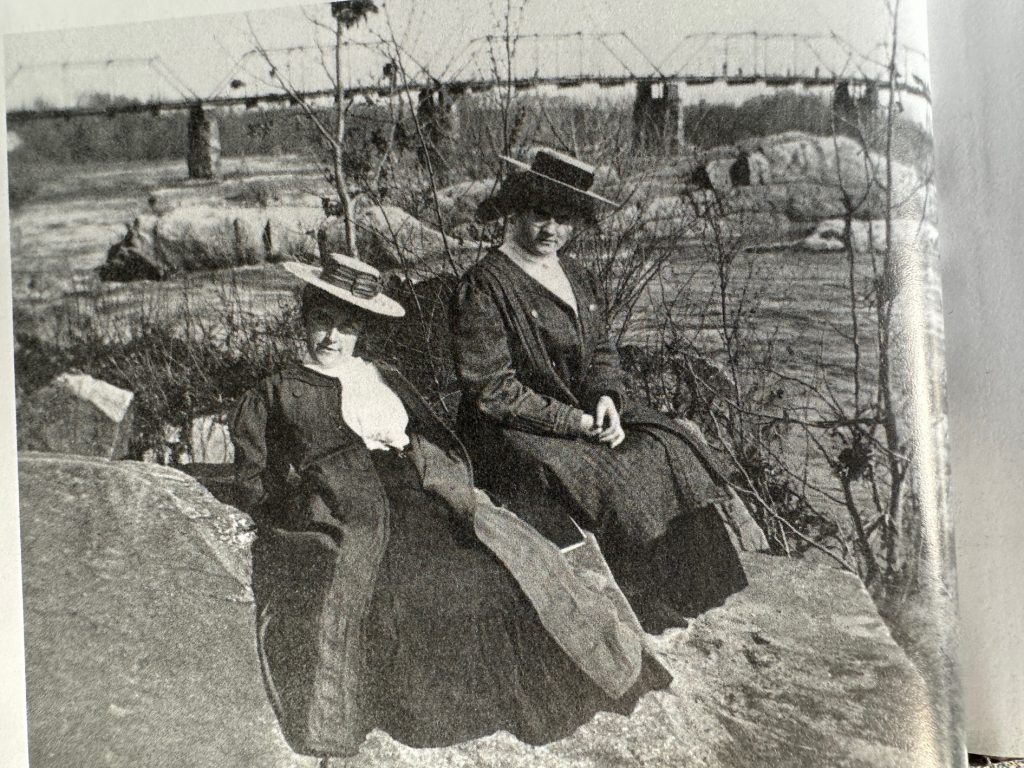
Winter 1918 – An ice dam took out five spans of the Falmouth Bridge. “The crash as thousands of tons of ice moved was heard throughout Falmouth…The large trees on the island above the bridge were moved along with the ice and are now standing in the mass below the bridge as though they grew there” (Daily Star, Feb. 13, 1918).
1937 – One year after a record flood of March 1936, another major flood struck Virginia on April 26, 1937. Heavy rains caused widespread flooding over all but southwest Virginia. The Rappahannock Basin was hit hardest. Falmouth and Fredericksburg saw its worst flood since 1889 when the river swelled to 30 feet above normal. Three bridge spans were lost, homes in low areas were partially submerged, and a score of gasoline storage tanks were swept away. The water level rose 39.1 feet above its normal level. This flood destroyed the steel Free Bridge. Its modern replacement is called the Chatham Bridge.
1942 – The worst flood in Stafford history happened on October 15-16, 1942. 10 to 12 inches of rain fell an hour, causing the Rappahannock River to rise to an historic level of 44 feet above normal. Damages were more than $2.5 million (in 1942 dollars). Over 1,300 people were left homeless in a 4 county area, and severe damages occurred to Virginia agricultural products, including millions of apples which dropped before they could be picked.
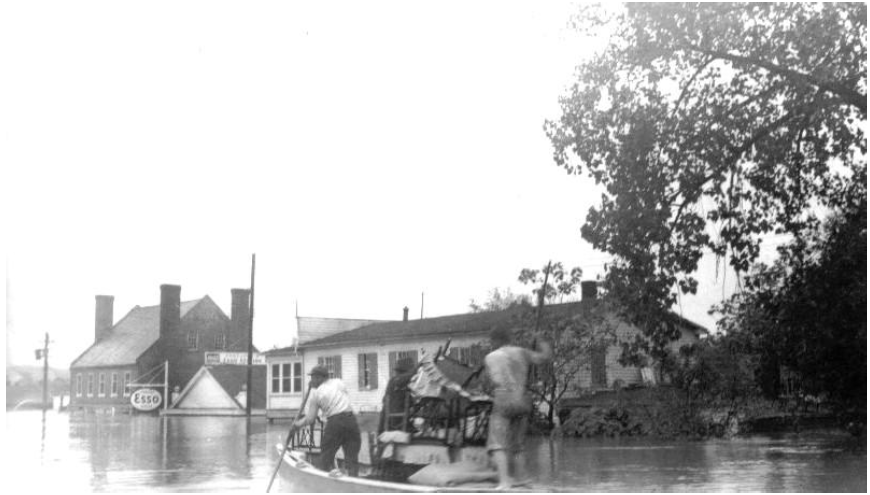
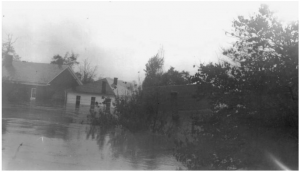
Stafford County Historian, Marion Brooks Robinson said, “Everything up to Washington Street had water up to the second floor. Ernestine Payne Hart’s house actually came off the foundation and floated down the Rappahannock River until it hit the Chatham Bridge.”


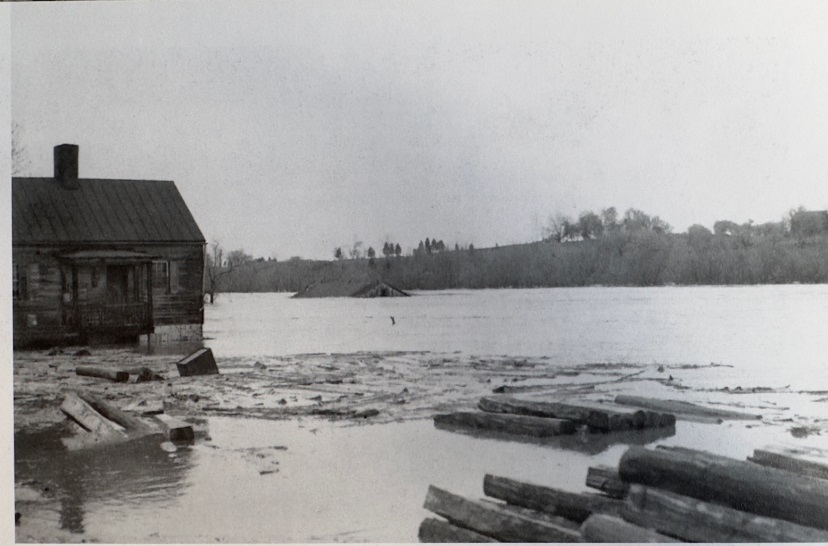

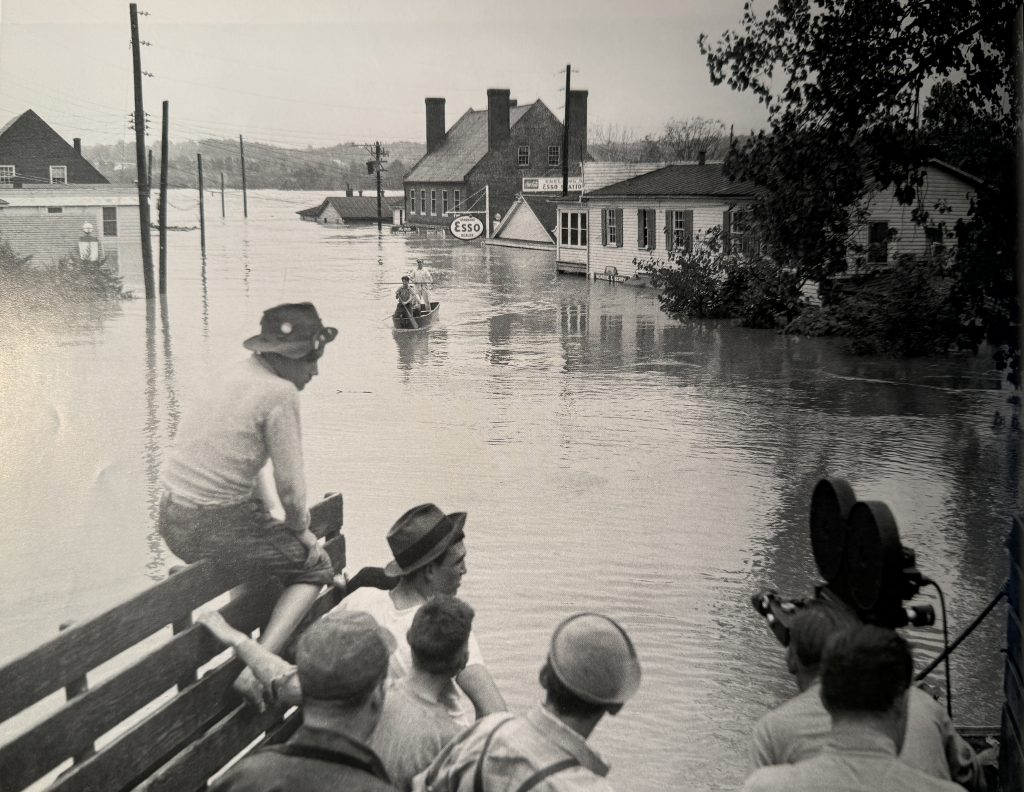
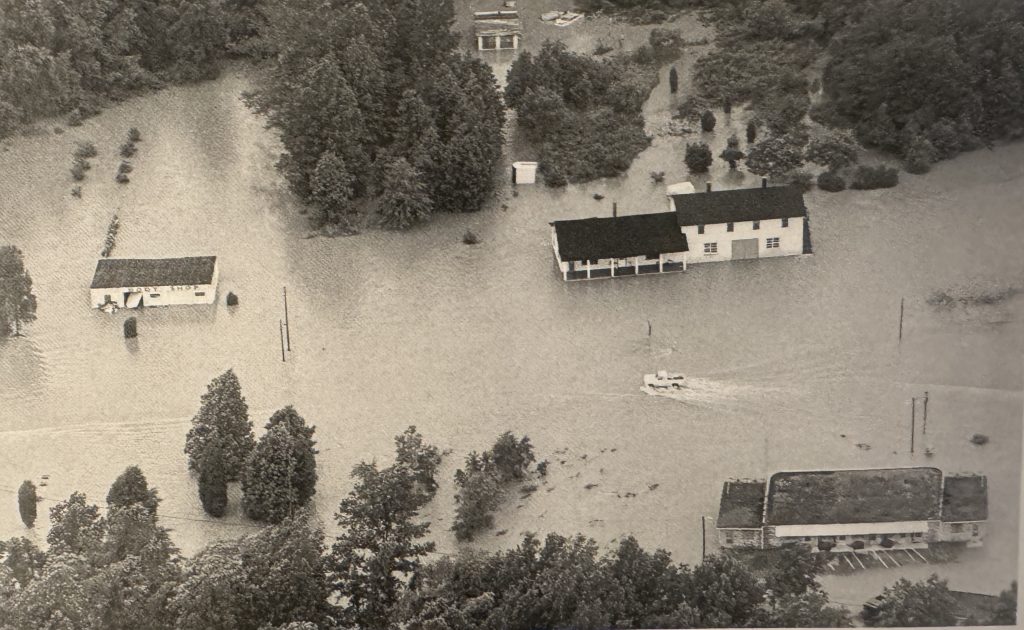
Courtesy Central Rappahannock Heritage Center.
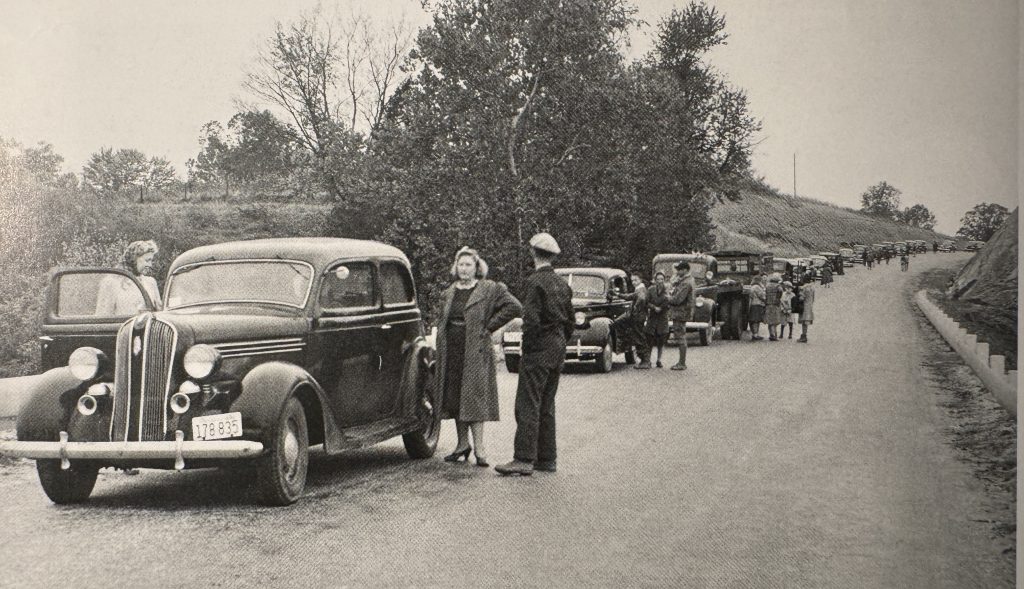
Courtesy Central Rappahannock Heritage Center.
“Both automobile bridges, Falmouth and Chatham, were torn up and were impassible. Aquia Creek Bridge (There was a bridge on Highway 1 by the present-day Saint William of York Church – going over Aquia Creek) had also washed away. Quantico Marines were wonderful. They put floating pontoons where the Aquia Creek Bridge went out and they would carry food and clothing and get truckers to haul it to Falmouth Church and Union Church. At the churches they distributed to people in need.”
Marion Brooks Robinson continues, “I was going to college at Mary Washington, so I had no clothes, only clothes I had on my back. I went through the generous offerings from the Marines and selected some much-needed clothes. A month later I was able to get to school, because the State Highway Department put up a walking pontoon bridge over the Rappahannock River. Prior to that, the only way to get to Fredericksburg was over the railroad bridge.”
Speaking of bridges, Barbara Decatur, Stafford’s Clerk of the Court, says that her father-in-law recalled being paid to look after the bridges in northern Safford. As a boy he would crawl on the Aquia Creek Bridge on Highway 1 and a bridge going into Quantico on Onville Road which passed over Aquia Creek too. He would check to make sure that the wooden slats were safe for travel.
Oral histories of many Fredericksburg citizens tell of the Fredericksburg flood of 1942. These histories and other information on file may be found in the Virginiana Room of the Central Rappahannock Regional Library.
1972 – Hurricane Agnes blew in on June 21, 1972 and brought another flood to our area. The water level was 39.1 feet above normal. President Nixon declared Fredericksburg and Stafford a disaster area.
1996 – Hurricane Fran (Sept. 6, 1996) was our fifth worst flood since 1889.

